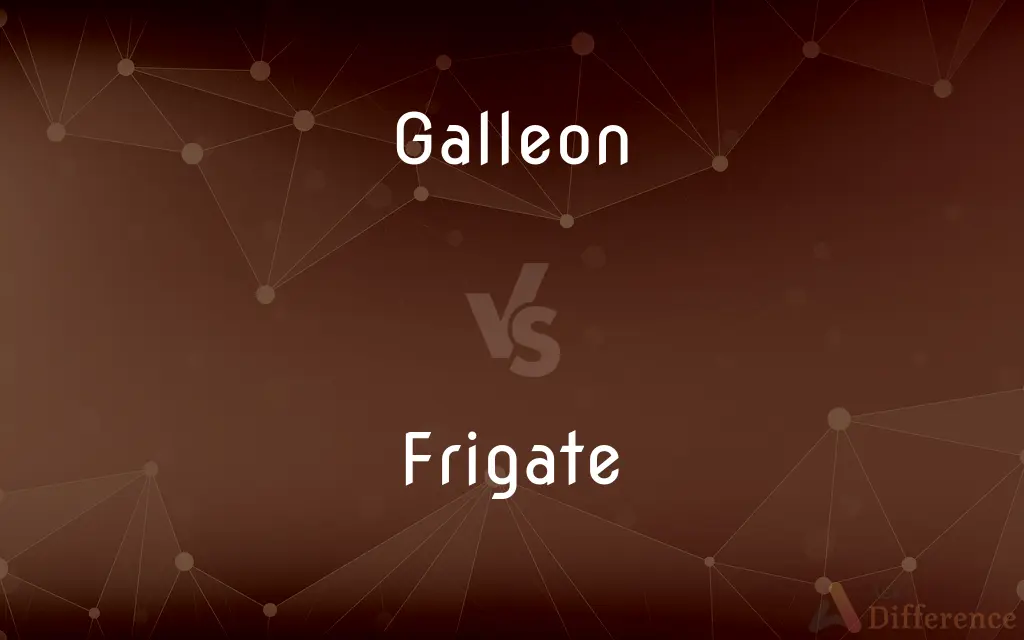Galleon vs. Frigate — What's the Difference?
By Maham Liaqat & Urooj Arif — Updated on March 18, 2024
Galleons were large, multi-decked sailing ships used from the 16th to 18th centuries, primarily for warfare and cargo, while frigates were smaller, faster ships used mainly for reconnaissance and escort duties.

Difference Between Galleon and Frigate
Table of Contents
ADVERTISEMENT
Key Differences
Galleons emerged in the 16th century as large, multi-decked sailing ships primarily used by European powers for long ocean voyages, warfare, and transport of valuable goods like silver and spices. These ships were characterized by their square rigging, high stern castles, and substantial cargo capacity. Frigates, developed in the 17th century, were smaller, faster, and more maneuverable than galleons, designed for speed and agility with a single continuous deck and lighter armament, making them ideal for reconnaissance, escort duties, and fast attacks.
The design of galleons evolved from earlier ship types to meet the demands of oceanic exploration and the need for durable vessels capable of both combat and carrying significant cargo. Their bulky structure and heavy armament made them dominant in naval warfare until more agile ship designs emerged. Frigates, on the other hand, were a response to the need for swift ships that could outrun heavier opponents, scout for enemy fleets, and protect merchant convoys from pirates and privateers.
Galleons played a pivotal role in the establishment and maintenance of overseas empires, serving as the backbone of colonial fleets, transporting goods, soldiers, and settlers between Europe and the Americas or Asia. Frigates contributed significantly to naval tactics, emphasizing speed and strategic engagement over brute force, often used in the Age of Sail for communication, reconnaissance, and showing the flag.
In terms of armament, galleons were heavily armed with cannons distributed across their multiple decks, designed to engage in intense broadside battles. Frigates, while also armed, carried fewer guns, focusing on speed and maneuverability to outflank opponents and deliver quick, decisive strikes, often avoiding direct confrontations with larger ships of the line.
Despite their differences, both galleons and frigates were instrumental in the naval history of the Age of Exploration and the Age of Sail, each serving distinct roles that reflected the evolving strategies and technologies of maritime warfare and exploration.
ADVERTISEMENT
Comparison Chart
Era
16th to 18th centuries
17th century onwards
Primary Use
Warfare, cargo transport
Reconnaissance, escort, fast attacks
Size and Structure
Large, multi-decked, bulky
Smaller, single continuous deck, sleek
Speed and Maneuverability
Relatively slow and less maneuverable
Fast and highly maneuverable
Armament
Heavily armed with cannons on multiple decks
Lighter armament, fewer cannons
Role in Naval Tactics
Dominant in naval warfare, brute force engagements
Emphasized speed, strategic engagement, avoiding direct confrontations
Compare with Definitions
Galleon
Large, multi-decked ships used for long voyages and warfare.
The Spanish galleon, laden with gold from the New World, sailed across the Atlantic.
Frigate
Designed for speed and agility, ideal for reconnaissance and escort duties.
The frigate swiftly navigated through the enemy fleet, relaying positions back to the admiral.
Galleon
Featured high stern castles and substantial cargo space.
The galleon's towering stern castles made it easily recognizable on the high seas.
Frigate
Carried lighter armament, focusing on strategic engagement.
The frigate's guns were fewer but well-positioned for quick strikes.
Galleon
Evolved from earlier ship designs to meet the needs of exploration and warfare.
The design of the galleon was a culmination of centuries of maritime innovation.
Frigate
Contributed to protecting merchant convoys from pirates.
The presence of a frigate was often enough to deter pirate attacks on vulnerable merchant ships.
Galleon
Served as the backbone of colonial fleets, transporting goods and troops.
Galleons carried settlers and supplies to the far-flung outposts of European empires.
Frigate
Played a key role in naval tactics, emphasizing maneuverability.
In battle, the frigate's speed allowed it to outmaneuver larger ships.
Galleon
Heavily armed to engage in naval battles.
The galleon's decks bristled with cannons, ready for combat.
Frigate
Reflecting naval strategy shifts towards more dynamic and fast-paced engagements.
The advent of the frigate marked a shift in naval warfare towards mobility and tactical finesse.
Galleon
Galleons were large, multi-decked sailing ships first used as armed cargo carriers by European states from the 16th to 18th centuries during the age of sail and were the principal vessels drafted for use as warships until the Anglo-Dutch Wars of the mid-1600s. Galleons generally carried three or more masts with a lateen fore-and-aft rig on the rear masts, were carvel built with a prominent squared off raised stern, and used square-rigged sail plans on their fore-mast and main-masts.
Frigate
A frigate () is a type of warship. In different eras, ships classified as frigates have had very varied roles and capabilities.
Galleon
A sailing ship in use (especially by Spain) from the 15th to the 18th centuries, originally as a warship, later for trade. Galleons were typically square-rigged and had three or more decks and masts
A Spanish treasure galleon wrecked off the Florida Keys
Frigate
A warship that is smaller than a destroyer and used primarily for escort duty.
Galleon
A large three-masted sailing ship with a square rig and usually two or more decks, used in the 1500s, 1600s, and 1700s, especially by Spain as a merchant ship or warship.
Frigate
A high-speed, medium-sized sailing war vessel of the 1600s, 1700s, and 1800s.
Galleon
A large, three masted, square rigged sailing ship with at least two decks.
Frigate
(Obsolete) A fast, light vessel, such as a sailboat.
Galleon
A sailing vessel of the 15th and following centuries, often having three or four decks, and used for war or commerce. The term is often rather indiscriminately applied to any large sailing vessel.
The galleons . . . were huge, round-stemmed, clumsy vessels, with bulwarks three or four feet thick, and built up at stem and stern, like castles.
Frigate
(nautical) Any of several types of warship:
Galleon
A large square-rigged sailing ship with three or more masts; used by the Spanish for commerce and war from the 15th to 18th centuries
Frigate
(historical) A sailing warship (of any size) built for speed and maneuverability; typically without raised upperworks, having a flush forecastle and tumblehome sides.
Frigate
(historical) A sailing warship with a single continuous gun deck, typically used for patrolling and blockading duties, but not considered large enough for the line of battle.
Frigate
(historical) A warship combining sail and steam propulsion, typically of ironclad timber construction, supplementing and superseding sailing ships of the line at the beginning of the development of the ironclad battleship.
Frigate
(historical) A escort warship, smaller than a destroyer, introduced in World War 2 as an anti-submarine vessel.
Frigate
A modern type of warship, equivalent in size or smaller than a destroyer, often focused on anti-submarine warfare, but sometimes general purpose.
Frigate
(fictional) A warship or space warship, inspired by one of the many historic varieties of frigate.
Frigate
A frigatebird (Fregata spp.).
Frigate
Originally, a vessel of the Mediterranean propelled by sails and by oars. The French, about 1650, transferred the name to larger vessels, and by 1750 it had been appropriated for a class of war vessels intermediate between corvettes and ships of the line. Frigates, from about 1750 to 1850, had one full battery deck and, often, a spar deck with a lighter battery. They carried sometimes as many as fifty guns. After the application of steam to navigation steam frigates of largely increased size and power were built, and formed the main part of the navies of the world till about 1870, when the introduction of ironclads superseded them.
Frigate
Any small vessel on the water.
Frigate
A medium size square-rigged warship of the 18th and 19th centuries
Frigate
A United States warship larger than a destroyer and smaller than a cruiser
Common Curiosities
How did frigates differ from galleons in terms of design?
Frigates were smaller, sleeker, and had a single continuous deck, designed for speed and maneuverability, unlike the larger, bulkier galleons.
Were galleons used in piracy?
While galleons were not typically pirate ships due to their size and crew requirements, they were often targets of piracy due to their valuable cargoes.
What was the main purpose of galleons?
Galleons were primarily used for oceanic voyages, warfare, and transporting valuable goods and troops across vast distances.
What role did frigates play in naval battles?
Frigates were used for scouting enemy positions, delivering messages, protecting merchant convoys, and engaging in fast, hit-and-run attacks.
Can galleons and frigates be found today?
While original ships are rare, replicas and preserved models of galleons and frigates can be found in museums and used in historical reenactments.
How did the armament of a galleon compare to that of a frigate?
Galleons had heavier and more numerous armaments spread across multiple decks, while frigates carried fewer, lighter cannons for speed.
Why were frigates important in the Age of Sail?
Frigates were crucial for their speed and agility, allowing navies to scout, communicate, and engage in tactical warfare more effectively.
How were frigates utilized outside of warfare?
Beyond their military role, frigates were used for exploration, showing the flag, and diplomatic missions due to their speed and range.
What advancements led to the decline of galleons?
Advances in naval architecture, armament, and the need for faster, more maneuverable ships led to the decline of galleons in favor of more agile ship designs.
Did galleons and frigates ever engage in combat with each other?
While possible, direct engagements were uncommon due to their different roles and capabilities; frigates often avoided combat with larger, more heavily armed ships.
Share Your Discovery

Previous Comparison
Sanitary vs. Clean
Next Comparison
Codex vs. IndexAuthor Spotlight
Written by
Maham LiaqatCo-written by
Urooj ArifUrooj is a skilled content writer at Ask Difference, known for her exceptional ability to simplify complex topics into engaging and informative content. With a passion for research and a flair for clear, concise writing, she consistently delivers articles that resonate with our diverse audience.















































